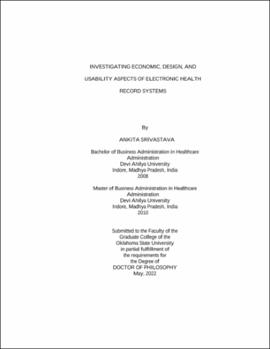| dc.contributor.advisor | Delen, Dursun | |
| dc.contributor.author | Srivastava, Ankita | |
| dc.date.accessioned | 2023-03-31T19:14:59Z | |
| dc.date.available | 2023-03-31T19:14:59Z | |
| dc.date.issued | 2022-05 | |
| dc.identifier.uri | https://hdl.handle.net/11244/337184 | |
| dc.description.abstract | Following a 3-essay approach, this dissertation explores three aspects of healthcare IT using three different methodologies. In the first essay, we use econometric modeling to quantify the business value of information exchange using spillover mechanisms and discuss its implications in propagating sustained collaboration between ambulatory and tertiary care. Leveraging a nationwide sample of 3,483 US hospitals across 13 years, matched with approximately 30,000 ambulatory care facilities, we find that focal hospitals' inpatient cost per discharge decreases as EMR adoption by neighboring ambulatory facilities increases. Further, these effects are more substantial for urban, densely populated regions with more ambulatory entities that are proximal. This represents the bright side of EHR use. Next, the second essay uses a qualitative approach to understand the unintended consequences or dark side of EHR use. In this study, we interviewed 24 physicians across 11 specialties to understand what specific EHR characteristics cause stress among physicians. Following the standard qualitative coding process, we identify fifty-one design issues and ten stress-inducing EHR design themes that provide a deeper understanding of the technostress phenomenon. In addition, our findings can be used by EHR vendors to design better information systems. The final and third essay contributes to the lack of usability testing models and presents a proof of concept EHR usability evaluation model based on discrete event simulation techniques. Using literature-based workflow sequence and time-motion data assumptions, we show how to use simulation techniques to evaluate whether an EHR system delivers operational value in physician utilization. Usability evaluation is the first step in designing better EHR systems, and thus our proof-of-concept model can be used by EHR vendors and certification authorities to appraise the operational value of EHR applications. Overall, this dissertation investigates- 1) the bright side of EHR use that generates economic value for its users; 2) the dark side of EHR use that provides a deeper understanding of the physician burnout problem; 3) provides a solution that helps in designing better EHR systems while mitigating its unintended consequences. | |
| dc.format | application/pdf | |
| dc.language | en_US | |
| dc.rights | Copyright is held by the author who has granted the Oklahoma State University Library the non-exclusive right to share this material in its institutional repository. Contact Digital Library Services at lib-dls@okstate.edu or 405-744-9161 for the permission policy on the use, reproduction or distribution of this material. | |
| dc.title | Investigating economic, design, and usability aspects of electronic health record systems | |
| dc.contributor.committeeMember | Bao, Chenzhang | |
| dc.contributor.committeeMember | Baham, Corey | |
| dc.contributor.committeeMember | Hess, Jim | |
| osu.filename | Srivastava_okstate_0664D_17709.pdf | |
| osu.accesstype | Open Access | |
| dc.type.genre | Dissertation | |
| dc.type.material | Text | |
| dc.subject.keywords | EHR design | |
| dc.subject.keywords | EHR usability | |
| dc.subject.keywords | electronic health records | |
| dc.subject.keywords | information blocking | |
| dc.subject.keywords | spillover | |
| dc.subject.keywords | technostress | |
| thesis.degree.discipline | Business Administration | |
| thesis.degree.grantor | Oklahoma State University | |
